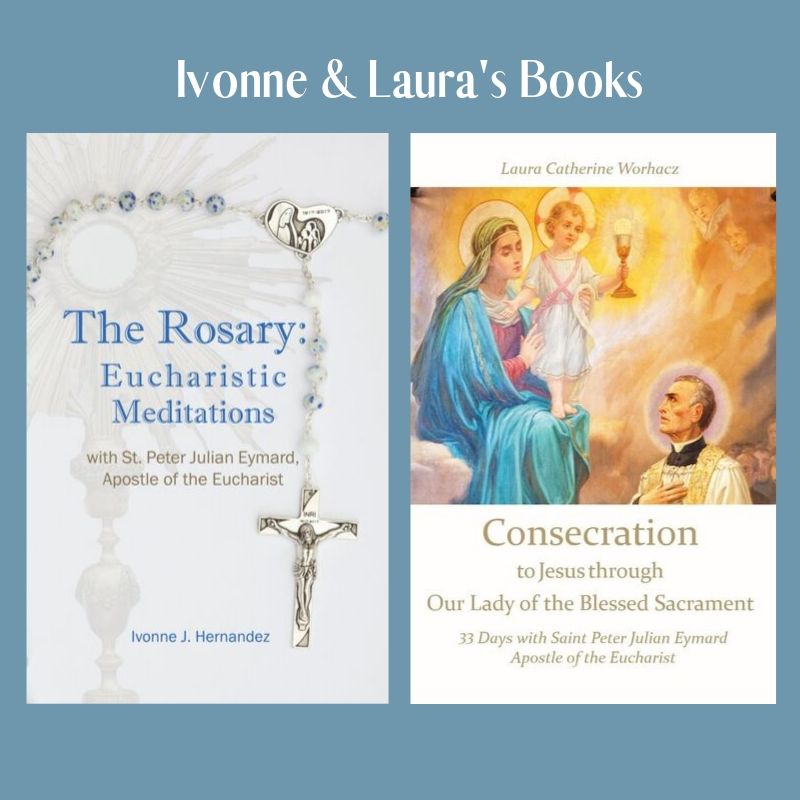ELISHEBA BLOGLaura, Ivonne, and Rick
write about their lives in the Eucharist. |
|
By Ivonne Hernandez To honor Our Lady, for the month of October, I will be re-posting the Eucharistic Meditations on the Mysteries of the Rosary, one set of mysteries each Saturday. This post includes all five meditations on the Sorrowful Mysteries, so it is longer than usual. I encourage you to mark this page so you can come back to it as you pray the Rosary this week. "All the mysteries have some relation to the Eucharist, for the Eucharist completes them all. They all tend toward the Eucharist; with the help of grace we must discover what is Eucharistic in the mysteries in order to nourish our devotion toward the Most Blessed Sacrament." – St Peter Julian Eymard 1. The Agony in the Garden "The agony of the Garden of Olives was already upon Him. At Gethsemane, Jesus would be saddened unto death at the sight of the ignominies in store for Him in His Passion. …But now, at the Last Supper, what a struggle went on in the Heart of Jesus! What anguish! …The Heart of Jesus was certainly not wavering, nor did it hesitate; but it was tormented. He saw His Passion renewed every day in His Sacrament of love… What was He to do? He would give Himself. He would give Himself just the same.” [1] - St Peter Julian Eymard “He knew beforehand the lukewarmness of His followers: He knew mine; He knew what little fruit we would derive from Holy Communion. But He wanted to love just the same, to love more than He was loved, more than man could make return for.” [2] - St Peter Julian Eymard Meditation: The first sorrowful mystery speaks to us of true contrition. When we meditate on the agony and suffering of Our Lord, our hearts open up to empathy. We see Jesus suffering deeply in His humanity, to the point of death, and upon realizing that we are the cause of such pain, we are moved to true contrition, a “sorrow of the soul and detestation for the sin committed, together with the resolution not to sin again.”(CCC, 1451) His grace keeps us from falling into despair and holds us up as we see the reality of our sin. With one word from His Sacred Heart, hidden in the Sacred Host, our hearts are pierced and mercy flows. Mourning is turned into dancing and with grateful hearts we praise and adore Him. St Peter Julian tells us that the agony of Our Lord began at the Last Supper. It was at that moment, the one He had been eagerly awaiting, that He saw how He would be treated in the Blessed Sacrament and His heart was tormented. He saw how many hearts would not love Him. He saw how many Judases would betray Him, how many Peters would deny Him. “He knew beforehand the lukewarmness of His followers: He knew mine”. Jesus knew all He would suffer, but He chose to give Himself anyway. His love for us is greater than our sin. In the Blessed Sacrament, He waits patiently for us to come and weep at His feet. He wants us to go to Him with the simplicity of a child. One time one my boys did something that made me really sad. He was feeling ashamed and disappointed at his behavior, but when he saw I was sad, he ran to me, hugged me, said he was sorry, that he wouldn’t do it again, and then he begged me to please not be sad anymore. The pain of hurting me was stronger than the shame of having broken the rules. Love was greater than his fear and he sought to console my heart. My heart was moved and we just hugged and wept. No more words were needed. Our hearts were speaking in the silence and in the tears. When we run to Jesus in the Most Blessed Sacrament with a contrite heart, when we finally return love for His love, all the pain and suffering melts away, and only love remains. 2. The Scourging at the Pillar "The Eucharist is the Divine lightning-rod that wards off the thunderbolts of Divine Justice. As a tender and devoted mother presses her child to her bosom, puts her arms around it, and shields it with her body to save it from the wrath of an angry father, so Jesus multiplies His presence everywhere, covers the world and envelops it with His merciful presence. Divine Justice does not know then where to strike; it dares not." [3] - St Peter Julian Eymard Meditation: The mystery of the scourging at the pillar speaks to us of forbearance, an extraordinary patient endurance under provocation. With extraordinary patience Jesus endured His Passion out of love for us. Bound to the pillar, He willingly took on the punishment for us, atoning for our sins and teaching us by His example. In the Eucharist He continues to be an example of forbearance for us. Bound to the bread and wine He waits for us, continually interceding to the Father on our behalf, until the end of time. Amid the blows life throws at us, and the scourging caused by our own sins, we faintly remember that “my help comes from the Lord.” (Psalm 121:2) When the pain is too much and we feel we are about to faint, amid the blows and the blood we seek His face and pray, Lord, “Hide me in the shadow of your wings!” (Psalm 17:8) The blows keep coming, but now we are shielded by His Body. He covers us with Himself so we can regain our strength. We see His beautiful face, loving us as He grimaces in pain. He is glad to suffer for us, to teach us what to do. He tells us to drink His blood, the one dripping from His wounds. Inebriated with this cup we’ll say, “But you have given my heart more joy than they have when grain and wine abound.” (Psalm 4:8) With this gladness now we see what we must do. We have the grace to endure too. We take our place like Him, over our neighbor who is feeling weak. We pass the cup with love and say, “take and drink, this is the blood He shed for you.” 3. The Crowning With Thorns “The honor paid to a friend in disguise, or to a king without his royal insignia, is greater than any other, because it is really the person who is then honored and not his trappings. So it goes with Jesus in the Most Blessed Sacrament; to honor Him, to believe in His Divinity in spite of the veil of weakness thrown over Him is to honor His Divine Person and to respect the mystery which envelops Him.” [4] - St Peter Julian Eymard “In union with the four and twenty ancients who cast their crowns in homage at the feet of the Lamb, lay your whole being, your faculties, and all your works in homage at the foot of the Eucharistic throne and say to our Lord: ‘To Thee alone be love and glory! … Holy Church entrusts this God to you that you may be her representative at His feet; offer Him her adoration.’” [5]- St Peter Julian Eymard Meditation: The mystery of the crowning with thorns speaks to us of courage. “He was spurned and avoided by men, a man of suffering, knowing pain.” (Isaiah 53:3) When we look at Jesus crowned with thorns, we see a contradiction: we see the “man of sorrows”, not a King. That contradiction is still present today in the Most Blessed Sacrament. The “veil of weakness thrown over Him” makes us not recognize His face. If we had been in that room when Our Lord was being mocked and spat upon, would we have had the courage to honor Him as our King? Do we have the courage to honor Him today in the Eucharist? One of the effects of the Sacrament of Confirmation is that “it gives us a special strength of the Holy Spirit to spread and defend the faith by word and action as true witnesses of Christ, to confess the name of Christ boldly, and never to be ashamed of the Cross.” (CCC, 1304) In the contradiction of the Blessed Sacrament, we are presented with a challenge. Either He is Who He says He is, or He is not. If we believe He is our King, then we must give Him homage. We must never be ashamed of the Cross. One time during Eucharistic Adoration, I was sitting in the back of the dimly lit church. Incense filled the room as it rose up in the glow of the Altar candles. As I moved my eyes down from the monstrance I saw a figure on the floor. It was the priest, prostrated before the Lamb, like He had been during his priestly ordination. This sight touched me deeply. The reality before me became clear, as he boldly proclaimed the name of Jesus with his actions. I wanted to lay myself at the feet of Jesus too, but I was afraid. What would people think? Would I be able to get up gracefully from the floor? Would I make a fool of myself? While I struggled with all these questions in my heart, the time for Adoration ended, and I left a little sad. The desire to prostrate myself in front of the Most Blessed Sacrament did not leave me, and eventually, months later, God gave me the courage to follow through on that desire and it was truly a moment of grace. We don’t have to physically lay ourselves down before the Eucharist to cast our crowns in homage, but we can ask for the courage to proclaim with our whole being, "To Thee alone be love and glory!”. 4. The Carrying of the Cross “I am the way, and the truth, and the life.” (John 14:6) “OUR Lord uttered these words while He was still among men, but He meant them to reach far beyond the short span of His human life. They belong to all ages; He can still repeat them in the Blessed Sacrament with as much truth as in Judea. …In the Eucharist He no longer performs the acts of virtues, but He has assumed them as His form of existence. We must make the acts and thus, in a way, complete our Lord. He thereby becomes one mystical person with us. We are His acting members, His Body, of which He is the Head and the Heart; so that He can say, "I still live." We complete and perpetuate Him." [6] - St Peter Julian Eymard Mediation: The mystery of the carrying of the Cross shows us the way we are to follow if we are to be true disciples of Christ. From embracing the Cross upon receiving it, to continuing all the way through the Via Dolorosa to Calvary, Our Lord exhibits all the virtues needed to reach the goal. He still exhibits them all in the Eucharist, so we can learn from Him and, as His mystical body, “complete and perpetuate Him”. “Whoever wishes to come after me must deny himself, take up his cross, and follow me.” (Matthew 16:24) These words from Jesus leave us with a very clear map of how are we to find the treasure of Heaven. The path goes straight though the Via Dolorosa, which means the way of suffering. We are not only to follow Him there, but we are to do it as we carry our own daily cross. Every morning when we see our cross, we are to embrace it like He did, for it is our key to the Kingdom. Each time we fall, we’ll see Our Lady right there with us, and with her help, we will get up again. Sometimes a Simon of Cyrene or a Veronica will come along our way, and sometimes we will be the ones called to ease someone else’s way. We will be mocked and insulted; we will get tired and wonder if we can go on. Blood and sweat will stream down our eyes, we won’t see Jesus in front of us and we’ll wonder if He’s still with us. Jesus knew our weakness and how difficult we would find it to follow this path, so not only is He leading us by going though it ahead of us, but He left Himself behind in the Eucharist as our nourishment and guide. From there He speaks to our hearts, “I am the way, and the truth, and the life.” (John 14:6) See how meek He is in the Eucharist, hidden and silent. Be meek like Him. See how He patiently waits for us to realize that there is something greater here, that He is everything we need. Be patient like Him. See how poor, gentle, strong, faithful, self-giving and loving He is. Be like Him. He wants us to receive Him and become one with Him, so that when we are carrying our cross, it is Him in us who is carrying it for us. With Him acting in us, and us acting in Him, we unite our sufferings to His, completing and perpetuating Him. We will say with St Paul, “Now I rejoice in my sufferings for your sake, and in my flesh I am filling up what is lacking in the afflictions of Christ on behalf of his body, which is the church.” (Col 1:24) 5. The Crucifixion "The Eucharist, in fact, is the fruit of the death of Jesus. The Eucharist is a testament, a legacy, which becomes valid only at the death of the testator. To give His testament legal force, Jesus had then to die. Every time we come into the presence of the Eucharist we may therefore say: "This precious testament cost Jesus Christ His life; He thereby shows us His boundless love, for He Himself said there is no greater proof of love than to lay down one's life for one's friends." [7] - St Peter Julian Eymard Meditation: The mystery of the Crucifixion speaks to us of the virtue of fortitude. The Catechism tells us that “the virtue of fortitude enables one to conquer fear, even fear of death, and to face trials and persecutions.” (CCC, 1808) When we look at the sacrifice on the Cross from the point of view of the Eucharist, we see the end before our eyes. We can then look at the Cross with hope and not despair. We go to the Eucharist, the living proof of His love, and we ask Him to show us the Way to Himself. He shows us the Cross. He shows us His glorified wounds, the fount of mercy by which our wounds are healed; we see them and remember the price He paid for them. We see how much He suffered for love of us. We touch His wounds and exclaim with St Thomas, my Lord and my God! We see Christ’s death as the price paid for the gift of Himself in the Eucharist, and our hearts are moved to gratitude. Gratitude moves us to want to give Him something in return, but what can we give Him? We only have our brokenness. We show him our own wounds and pain. This is what He was waiting for. He touches our wounds and hides them within His, transforming them with His love and driving away all fear. We are united through the pain, in a deep embrace of love. We find sweetness on the cross, the sweetness of being one with Him. Our pain is still there, but we are not alone, and we are not afraid. With fear now gone, we can see our suffering in the light of the Eucharist. We see that it is by uniting our wounds to His wounds that we find the pathway by which mercy will flow from Him to us, and from us to others. It is in the Eucharist, His last will and testament to us, that we find the strength we need to die to our own will and accept the sufferings that come our way. [1] Eymard, The Real Presence, p.40 [2] Eymard, The Real Presence, p.152 [3] Eymard, The Real Presence, p, 165 [4] Eymard, The Real Presence, p.62* [5] Eymard, The Real Presence, p.19* [6] Eymard, The Real Presence, p.192 [7] Eymard, The Real Presence, p.73
0 Comments
Your comment will be posted after it is approved.
Leave a Reply. |
Categories
All
FOLLOW US ON SOCIAL MEDIA:
AuthorsWe are Ivonne J. Hernandez, Rick Hernandez and Laura Worhacz, Lay Associates of the Congregation of the Blessed Sacrament, and brothers and sisters in Christ. |
Copyright © 2024 Elisheba House Inc.
Elisheba House is a 501(c)(3) non-profit organization. Federal Tax ID Number 84-1894146
Florida registration for Solicitations of Contributions #CH71652
A COPY OF THE OFFICIAL REGISTRATION AND FINANCIAL INFORMATION MAY BE OBTAINED FROM THE DIVISION OF CONSUMER SERVICES BY CALLING TOLL-FREE (800-435-7352) WITHIN THE STATE. REGISTRATION DOES NOT IMPLY ENDORSEMENT, APPROVAL, OR RECOMMENDATION BY THE STATE.
Florida registration for Solicitations of Contributions #CH71652
A COPY OF THE OFFICIAL REGISTRATION AND FINANCIAL INFORMATION MAY BE OBTAINED FROM THE DIVISION OF CONSUMER SERVICES BY CALLING TOLL-FREE (800-435-7352) WITHIN THE STATE. REGISTRATION DOES NOT IMPLY ENDORSEMENT, APPROVAL, OR RECOMMENDATION BY THE STATE.



 RSS Feed
RSS Feed